This simple apricot jam is made with just fruit and sugar. The recipe is calculated using a three to one ratio, so it can easily be scaled up or down, depending on how many apricots you have to start.

This is the first summer in nearly six years that I’m not working on a cookbook. While this scares me a little bit (I like knowing that I have the next project locked down), it also feels totally liberating. Because it means that I am free to make whatever I want. What’s more, everything I make can eventually make it to the blog. I don’t have to hold anything back.
A couple weeks ago, I got about 22 pounds of apricot seconds from a local grower. If I was producing for a book, those apricots would have been earmarked for particular projects. I would have needed to have made interesting flavor combinations. What’s more, I would have been timing every aspect of the cooking process, to be sure that I could accurately represent the process in writing.
Instead, I made three large batches of plain, unadulterated, totally simple apricot jam. Just apricots and sugar, measured by weight, macerated overnight, and cooked down into slightly runny, intensely tart, vividly orange jam.
Because, my friends, as much as I like apricot butter, apricot jam spiked with rosemary or thyme, and apricot chutney, this very simple apricot jam is one of my favorite things on the planet. And because I was canning only to please myself, that is what I made.
My whole sensory self was engaged as the jam cooks. I watched the bubbles, felt the fruit thickening as I stirred. The fragrance of cooking sugar rode up with the steam and the sound of the boil became more frenzied as the process neared completion.
This is not canning that easily fits into a book. It doesn’t bring anything new or novel to the table. It is, in fact, how people have been making jam for a very long time. But it brings me joy. It’s artful, creative jam making.
A note on working with seconds. Normally, when calculating recipes by weight, I measure out the fruit before I pit and quarter it, figuring that the loss will be minimal. However, when I’m working with seconds that require more trimming and culling than unmarred fruit, I wait until after I’m done with the prep work to weigh the fruit and calculate how much sugar to use. It’s this second approach that you’ll see reflected in the recipe below.

Basic Apricot Jam
Ingredients
- 6 pounds pitted trimmed, and roughly diced apricots
- 2 pounds sugar
Instructions
- Combine the apricots with the sugar and let them macerate for at least an hour (overnight is even better).
- When you're ready to cook, prepare a boiling water bath canner and enough jars to hold around 5 pints of product (I use a combination of quarter, half and full pints for my jam).
- Pour the macerated fruit into a low, wide, non-reactive pan and set it over high heat.
- Bring the fruit to a boil and cook, stirring occasionally at the start of cooking, and nearly constantly towards the end.
- The cooking process will take anywhere from 15 to 30 minutes, depending on the width of your pan, the water content in the fruit, and the heat output of your stove.
- You're looking for the jam to get glossy, for thick layers to form on the walls of the pan, and for the jam to sheet nicely off your spoon or spatula. When it does all that, it will be done.
- When the jam is thick enough for you, remove the pan from the heat and funnel the jam into your prepared jars.
- Wipe the rims, apply the lids and rings, and process in a boiling water bath canner for 10 minutes. When the time is up, remove the jars from the canner and set them on a folded kitchen towel to cool. When the jars are cool enough to handle, test the seals. Sealed jars are shelf stable for a year or more. Unsealed jars should be refrigerated and used promptly.
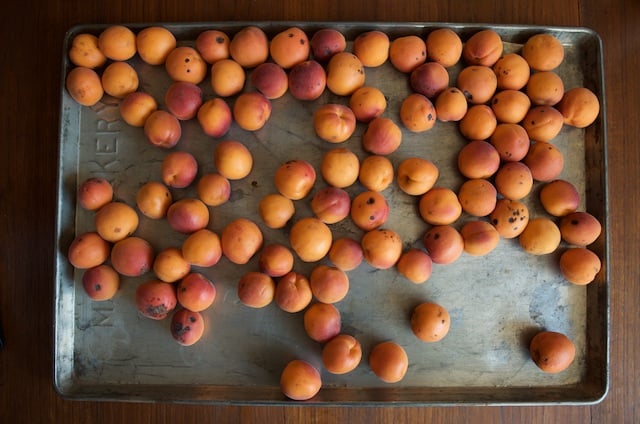
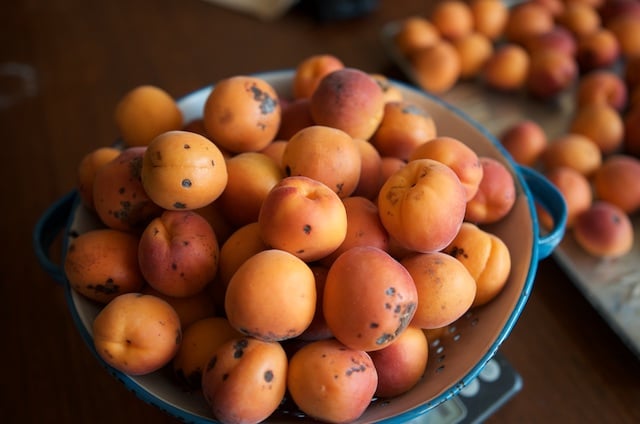
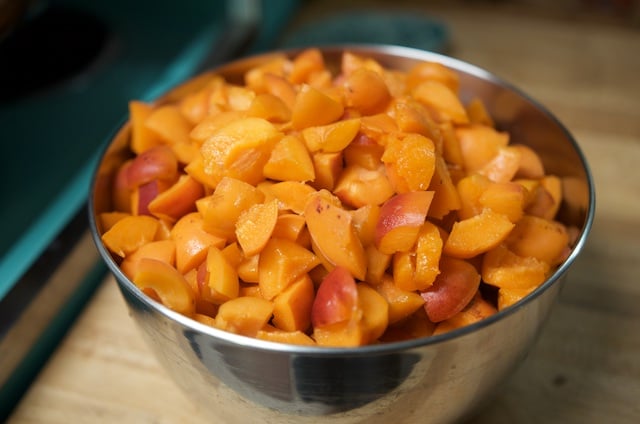

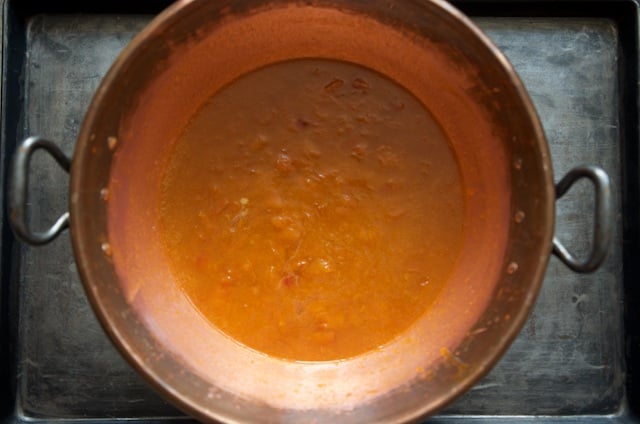
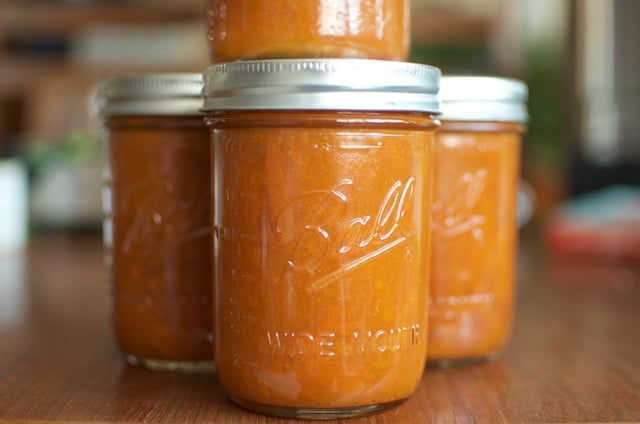

If I am wanting to macerate the apricots overnight, do I leave them out on the counter or do they need to go in the fridge?
Ideally they should go in the fridge. If you leave them out, they could begin to ferment and get boozy.
Is it safe to just leave out the sugar and to water bath can with only apricots?
It would be safe to can apricots without any sugar, but they won’t hold their quality nearly as long. Sugar isn’t just a sweetener, it’s also a preservative. Apricots canned without any sugar will lose their color and flavor quickly.
Thank you so much for this recipe. Will the jam turn brown over time without the lemon juice or ascorbic acid? Or because they’ve been macerated in the sugar they should retain the bright orange color?
If you keep the jars out of direct sunlight, they should hold their color for at least a year.
I love the simplicity of your recipe but have a question: My comment touches on 2 of your replies: one to Deidre about adding some spices and one to Julie about adding lemon juice. You say that Apricots are acidic enough that you don’t need to add the lemon juice and that the small amount of spice that Deidre wanted to add would be ok because of the Apricot’s natural acidity. So, with that said, would it be ok to add a jalapeno or 2 (depending on spiciness) if i do add some lemon juice? Say a couple of tablespoons? thanks!!
If you want to make the jam spicy, you could use jalapenos. However, I would cook the jam with them in and them remove the jalapenos before canning (cut them in half and remove the seeds before cooking) for a spicy jam. Leaving that much pepper material in the finished jam is a great deal more acid impact that adding a small amount of dried spice.
Yes, that helps very much. Also, I just re-read the recipe (including your notes) and see that you already answered my question, so SORRY!!!! I”m making your spicy apricot jam now, will make this jam later in the week. Thank you soooo much!!
So glad I could help! Enjoy the jam!
Marisa, Could you please confirm that you weigh the 6#s of apricots AFTER you pit them. Rather than pitting/trimming 6 pounds of apricots. Thanks, and sorry if this is a dumb question!
Not a dumb question. Because I was working with apricots that had a lot of bruising when I wrote this recipe, I pitted, culled and diced before taking the weight. If your apricots are firsts and are in good shape, you can safely weigh the six pounds before you start pitted and cutting, because the loss is fairly minimal. Does that help?
What is the yield of this recipe? Is it 5 pints? Debating doubling the batch but 10 pints mayyy be too much.
Yes, the yield was around 5 pints. I wouldn’t recommend doubling the recipe though because it probably won’t set up. If you increase the volume in the pot without increasing the surface area, you make it hard for enough water to evaporate out of the fruit and create sufficient temperature elevation to effect the set.
Our old apricot tree is a late bloomer. After 20 years of almost no fruit, much of it came in at once. We used 10 pounds of apricots, which resulted in 12-8oz jars of jam. I micro-planed a heaping teaspoon of ginger into 4 cups of jam I had separated into a saucepan where I cooked it an additional 10 minutes. Thank you for your wonderful traditional recipe and straight forward instructions. It was a pleasure to get right to it and not have to make my way through a bunch of unnecessary yakking first. Also, this is the first time my husband has ever been involved in jam-making. He really enjoyed the experience too. I hear our jars popping right now!
Love love love this recipe. Made it today and it is A+. Thank you!
Made this tonight with about 3 lbs of local Michigan apricots. The raw apricots were a little bland but they cooked up into one if the most flavorful jams I’ve ever made. Delicious!
This looks good but apricot season is over here in California. Maybe next year I will try this. I have 15 jars of apricot jam made with Pamona’s Pectin that will be long gone before the next apricot crop is here.
Will the 3-1 ratio work with most fruits and berries?
It will work, though some things will want some additional pectin (or will be runny).
This is so timely – I’m meeting with a friend tomorrow who has an apricot tree and wants to learn how to make jam. Thanks so much! A quick question though, if we want to add a little cinnamon and nutmeg to a batch, will that throw off the acidic content?
Adding those spices won’t throw anything off. Small amounts of spices can always be safely added to recipes such as this.
I so agree with you Marisa. Simple is joyful and soul-satifying. My mouth is watering. Sadly, the Northeast will not see much in the way of stone fruits due to the late freeze.
Oh thank you Marisa. This recipe is just what I needed! I ran out of my bottled lemon juice last night and was hoping to not go to town at all today. I can still make my jam though (I have apricots and peaches sitting on my counter). Hooray!
I made your small batch apricot jame last week when I found two pounds of apricots at a great price! Turned out great! Apricots are showing up at farm stands here in the Seattle area now and I will be looking for more! Love your copper jam pot. I have one similar to it which I have used for years. Thanks for your blog.
i’ve got this recipe marked for when my baby apricot tree grows up and starts to produce. How beautiful!
It looks delicious !! thank you for the simple instructions. Love your blog!
As fun as new combinations are, there’s also something special about making just a two-ingredient jam of something you like. You didn’t put in some lemon juice? I wasn’t sure if apricots were acidic enough on their own.
Apricots are plenty acidic on their own. According to the FDA, they generally have a pH of between 3.s and 4.0. That’s well below the 4.6 cut-off.
I totally agree with you about apricot jam. Simply apricots and sugar can be transformed into the sublime.
will this work with peaches too?
Yes. The cooking time might be a little longer for peaches, as they’re often a bit waterier than apricots.